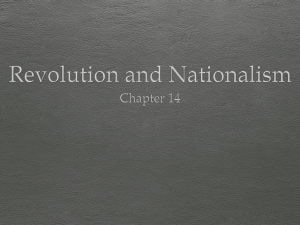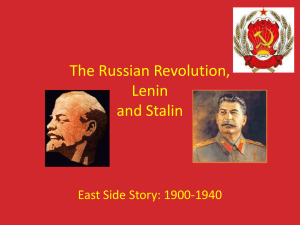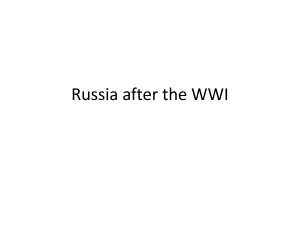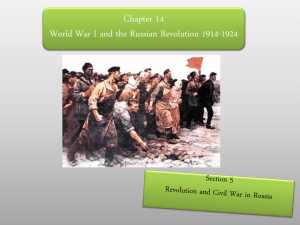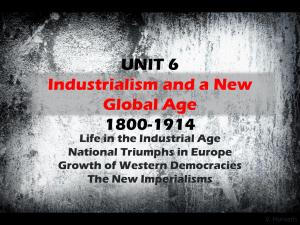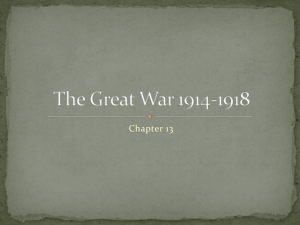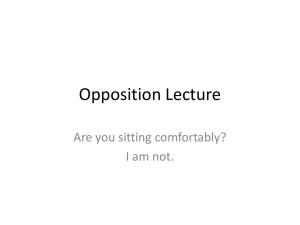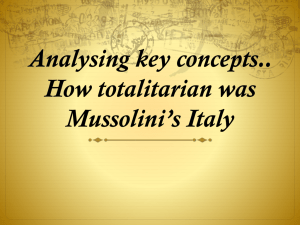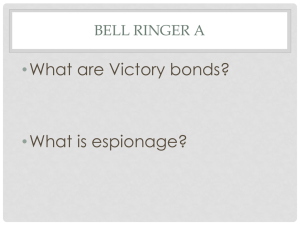Russian Revolution and Totalitarianism
advertisement
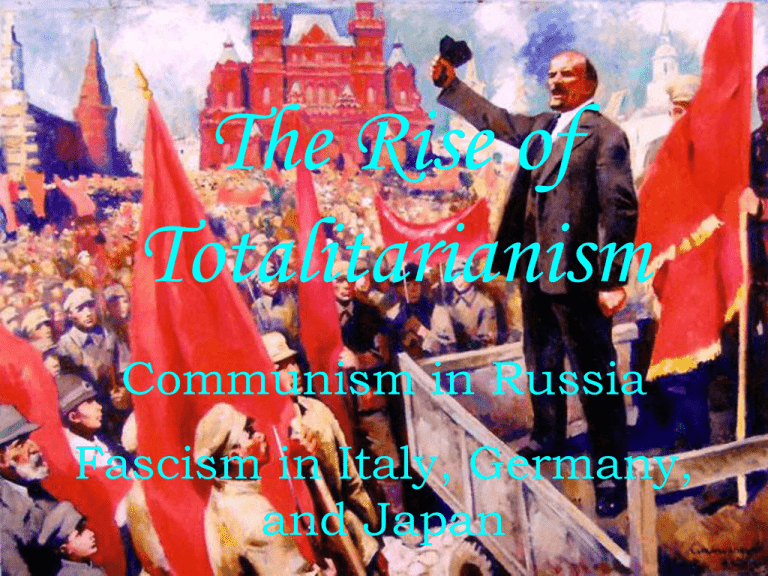
The Rise of Totalitarianism Communism in Russia Fascism in Italy, Germany, and Japan Totalitarian states have governments that have complete control over every aspect of people’s lives. Hitler did not get elected by promising the Hitler was elected because he German people that he would lead them into fear of Howpromised did to improve German another World War… kill millions of terrorists provide totalitarian education… childstart care the for Holocaust… create Death Germans… governments working mothers… Camps… improve destroy the German cities… Secret Police come to and get more jobs… and economy encouraging power? restore German pride Laws to “Protect” citizens informants Convinced the German people to trade their freedoms for protection from evil enemies Scapegoating evil enemies of the people How did totalitarian governments keep Why did people turn over control over the theirCould control to a a totalitarian government take over the people? totalitarian government? United States of America? Totalitarian states are ones where the governments have complete control over all aspects of people’s private and public lives. Rise of Totalitarian States (1919-1941) InJapan, Russia, hundreds of years of debts rule byfrom Czars was of InAfter astruggled series Emperor of weak Hirohito governments lost power inthe to Italy, the military Germany to repay the theBenito Treaty These leaders used secret police, fear of foreign attack, replaced byto revolutionaries. Vladimir Lenin tried to Mussolini who came and the dominate Fascist Japanese Party come society. to power. Japanese They Versailles. Hatred of the treaty (and War Guilt Clause) and propaganda to take total control over every aspect modernize Russia before Joseph Stalin created athe totalitarian militarism would create lead a totalitarian to war with society. Europe and the and enormous economic troubles leads to riseUSA. of of their people’s public and private lives. state. Adolf Hitler. Rise of Nationalism after world war I The Russian Revolution • a feudal society (farmer based) • Russian Czar not able to adapt to a changing world • poor leadership and extreme hardships during the First World War • bloody death of the royal family • symbol of hope for the poor people of the world as the Russians started democratic reforms • seen as a threat by Western leaders •betrayed by leaders seeking power who turned Russia into a totalitarian society Rise of Russian Nationalism Czar Alexander II (1855-81) • abolished serfdom on March 3, 1881, and introduced many reforms • he was assassinated in 1881 Czar Alexander III (1881-94) • more police and new laws • he also undid many of the reforms that his father had introduced Czar Nicholas II (1894-1917) • disastrous military leader • abdicating in 1917, he was imprisoned by the Red Army • he and his family were killed in the Ural Mountains For over 300 years the Romanov family ruled Russia. In 1917, the rule of the family came to a violent end. Russia struggled to find a balance between the desire to industrialize and the reality of having a country that was mostly made up of peasant farmers. By 1900, a small The Russian Revolution Russian Revolution and Rise of Fascism 1. Two Revolutions in Russia A. March 1917, political, economic, and social conditions in Russia started a revolution that overthrew the Czar The end of the Russian Monarchy In 1917, the Czar abdicated. Democracy came to Russia. The Russians set up Soviets – the local branches of workers parties. Lenin’s Bolshevik party changed its name to Communists – after Karl Marx’s classless society. In November 1917 Lenin and the Bolsheviks took over power in Russia. Lenin was a dynamic leader. Democracy spread…at first… Lenin takes control of Russia 1. Two Revolutions in Russia A. March 1917, political, economic, and social conditions in Russia started a revolution that overthrew the Czar B. Bolsheviks (Communists – led by Lenin) seized power in OCtober 1917 i. ended private ownership of land ii. gave land to peasants iii. gave workers control of factories and mines iv. ended Russia’s involvement in World War I When Russia withdrew from World War I, a civil war broke out. The Revolution was opposed by some Russians (they became known as “White Russians”) A Civil War devastated Russia Over 15 million Russians die during the Civil War… Russia would have a difficult time trusting the Allies again… The Russians at first think that their Revolution would be welcomed by the American American and Allied and French people (who hadforces also had invade and successful occupy revolutions for much of freedom and Russia democracy) The Russians write letters of goodwill to the Americans… who immediately send troops into Russia to put down the Revolution… How did Western Nations respond to the Russian Revolution? In the USA discrimination white men voted rich industrialists owned everything sharecropping Western leaders sent their In Russiaarmies into Russia to equality overthrow the everyone voted revolution and restore the given Czar. workers were control of factories peasants were given land The Russian Revolution mightbybecome dangerous Western countries were controlled wealthy a leaders who example tothat the in had theaswest. saw the new ideas thepoor Russians dangerous. Russia fights Civil War and is attacked by Western Powers 1. Two Revolutions in Russia A. March 1917, political, economic, and social conditions in Russia started a revolution that overthrew the Czar B. Bolsheviks (Communists – led by Lenin) seized power in October 1917 i. ii. iii. iv. ended private ownership of land gave land to peasants gave workers control of factories and mines ended Russia’s involvement in World War I C. three year civil war between the Communist Red Army and the Whites, people who were loyal to Czar The Revolution and Civil War left Russia poor and destroyed. To improve the economy, Lenin started the NEW ECONOMIC POLICY But, what about Russia? By 1900, Europe enjoyed the benefits of the Industrial Revolution. The Industrial Revolution brought about huge changes in society. Philosophers tried to explain the way that the world had changed. The most influential thinker of the times was a German named Karl Marx... Lenin tries to modernize Russia Much of the success of the Russian Revolution comes from the work of Lenin. He is charismatic and dynamic. He realizes that the proletariat society does not exist in feudal Russia. A classless society could only exist once the urbanized working class took control of Russia. But Russia had never been through a capitalist phase. So Lenin introduces the NEW ECONOMIC POLICY, making the state develop a kind of capitalist society. 2. From Lenin to Stalin A Under Lenin, the Communist Party used the army and secret police to enforce its will. In economics, Lenin mixed capitalist and socialist ideas. Lenin is followed by Joseph Stalin. Stalin creates a totalitarian society in Russia. 2. From Lenin to Stalin A Under Lenin, the Communist Party used the army and secret police to enforce its will. In economics, Lenin mixed capitalist and socialist ideas. B. After Lenin died, Joseph Stalin took over i. tried to make USSR a modern industrial state farm land was taken away Russia had missed the by the government and Capitalist phase peasants forced to work on huge collectivized farms Stalin tried to skip Capitalist phase by allowing the state to develop the Russian economy eventually the state would “hand over” control of the economy to the “dictatorship of the proletariat”… Stalin introduced 5-yearhuge factories were built plans for industrial and with millions of people agricultural improvements being encouraged to work to make the state stronger 2. From Lenin to Stalin A Under Lenin, the Communist Party used the army and secret police to enforce its will. In economics, Lenin mixed capitalist and socialist ideas. B. After Lenin died, Joseph Stalin took over i. tried to make USSR a modern industrial state ii. all economic and agricultural activity under government control iii. 5-year-plans to increase production Stalin’s Great Purge In 1934 Stalin targeted his enemies for elimination. By 1939 Stalin had complete control of the country. Historians estimate that Stalin was responsible for between 8-13 million Russians. 2. From Lenin to Stalin A Under Lenin, the Communist Party used the army and secret police to enforce its will. In economics, Lenin mixed capitalist and socialist ideas. B. After Lenin died, Joseph Stalin took over i. tried to make USSR a modern industrial state ii. all economic and agricultural activity under government control iii. 5-year-plans to increase production C. In 1934 Stalin started terror - Great Purge (4 million people were purged and almost 800,000 were executed). How did Stalin maintain control over the USSR? Secret police Propaganda Censorship Terror • arrested opposition • government controlled all media • against the law to criticize • Great Purge • spied on people • even family members spied • encouraged obedience to the state • government controlled everything people heard, saw, or read • constant fear of midnight “knock on the door” • sent to labor camps - gulags 3. Life in a Totalitarian State A. Stalin used secret police, propaganda, censorship, and terror to establish a totalitarian state. B. Leaders were Communist Party members, industrial managers, military, scientists, and some artists and writers. “Literature, the cinema, the arts are levers in the hands of the proletariat which must be used to show the masses positive models of initiative and heroic labor.” Socialist Realism 3. Life in a Totalitarian State A. Stalin used secret police, propaganda, censorship, and terror to establish a totalitarian state. B. Leaders were Communist Party members, industrial managers, military, scientists, and some artists and writers. C. Artists and writers forced to use “socialist realism” (tried show Soviet life in a positive way). While the Russians struggled to adapt to the changes that the ending of their monarchy brought, the rest of the world also struggled to understand what had After World War I, people everywhere questioned old ideas about religion, leadership, and even science. Albert Einstein develops the Theory like Sigmund ofMen Relativity which Freud new upsetsdeveloped scientific ideas about what beliefs held since motivated people. Isaac Newton. 4. A Culture in Conflict A. new ideas and science changed ideas about the world i. atomic theory ii. theory of relativity iii. psychoanalysis 4. A Culture in Conflict A. new ideas and science changed ideas about the world i. atomic theory ii. theory of relativity iii. psychoanalysis B. new literature and the arts lead to a sense of uncertainty After women won the right to vote in Russia, western nations that claimed to be democratic finally were forced to give women the vote. 4. A Culture in Conflict A. new ideas and science changed ideas about the world i. atomic theory ii. theory of relativity iii. psychoanalysis B. new trends in literature and the arts contributed to a sense of uncertainty C. women made progress in education and politics but still lagged behind men in career opportunities and pay International Relations The War to End All Wars ended on November 11, 1918 Europe Over 21 millionwas left to wonder what had Over 8,500,000 happened… men returned men died injured Over 65 million The war men cost were over mobilized… $31,000,000,000 Theresomeone were 37,500,000 had to pay…the casualties… question was who… Despair Atheism Suicide Distrust of government NEVER AGAIN Frustration Hopelessness Anger Leadership failure Futility Nihilism 5. The Western Democracies A. after World War I diplomats worked hard to make: i. treaties that ended war The League of Nations After World War I, President Woodrow Wilson proposed the 14 Points for peace. One of Wilson’s ideas was to create a League of Nations. The League excluded Germany and Russia. Most importantly, Americans did not seem sure that the League was a good idea. The U.S. Senate decided to reject Wilson’s plans for the League. The USA never joined… 5. The Western Democracies A. after World War I diplomats worked hard to make: i. treaties that ended war ii. cooperation in the League of Nations 5. The Western Democracies A. after World War I diplomats worked hard to make: i. treaties that ended war ii. cooperation in the League of Nations B. leading democratic powers faced difficult political and economic challenges at home and abroad The Great Depression begins Black Tuesday Hoovervilles 5. The Western Democracies A. after World War I diplomats worked hard to make: i. treaties that ended war ii. cooperation in the League of Nations B. leading democratic powers faced difficult political and economic challenges at home and abroad C. the Great Depression created financial turmoil and widespread suffering throughout the industrialized world Rise of Fascist Italy • preached extreme nationalism • nations must struggle – peaceful nations were doomed • no clearly defined program for improvement • citizens lose individual rights • state is supreme Italians were furious that they were not given more land after World War I. They also feared a Communist Revolution like Russia. Many were attracted to the idea of a strong leader. Benito Mussolini 6. Fascism in Italy A. Benito Mussolini and his Fascist Party took advantage of political and economic unrest to seize power in the 1920s. Mussolini’s Aggression 6. Fascism in Italy A. Benito Mussolini and his Fascist Party took advantage of political and economic unrest to seize power in the 1920s. B. Fascism was rooted in extreme nationalism and glorified action, violence, discipline, and loyalty to the state. C. As Il Duce, Mussolini established the first totalitarian state which served as a model for others. Rise of Adolf Hitler 7. Hitler and the Rise of Nazi Germany A. Weimer Republic weakened by disunity and inflation. Many blamed the government for the hated treaty of Versailles Adolf Hitler 7. Hitler and the Rise of Nazi Germany A. Weimer Republic weakened by disunity and inflation. Many blamed the government for the hated treaty of Versailles B. Hitler appealed to extreme nationalism, anti-Semitism, anti-communism, and resentment of the Treaty of Versailles Hitler’s Rise to Dictator • in 1933 Hitler became Chancellor of Germany (Weimer Republic) • he did not have a majority • he called for new elections • six days before the elections, the Nazis burned down the Reichstag and blamed Communists • Hitler won a small majority and declared a one-party state 7. Hitler and the Rise of Nazi Germany A. Weimer Republic weakened by disunity and inflation. Many blamed the government for the hated treaty of Versailles B. Hitler appealed to extreme nationalism, anti-Semitism, anti-communism, and resentment of the Treaty of Versailles C. Hitler and the Nazis used terror, repression, and one party rule to create a totalitarian society 7. Hitler and the Rise of Nazi Germany A. Weimer Republic weakened by disunity and inflation. Many blamed the government for the hated treaty of Versailles B. Hitler appealed to extreme nationalism, anti-Semitism, anti-communism, and resentment of the Treaty of Versailles C. Hitler and the Nazis used terror, repression, and one party rule to create a totalitarian society D. Economic problems and ethnic tensions in Eastern Europe helped fascist dictators gain power there


